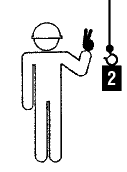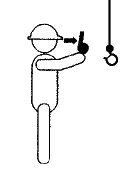When should the crane operator follow hand signals? Who can give the hand signals? or Who can be a signaler? What should you do when in charge of signaling? What are examples of some common hand signals? What are some common hand signals for crawler, truck and locomotive cranes? What are some signals for crawler cranes only? When should the crane operator follow hand signals?
A crane operator should always move loads according to the established code of signals, and use a signaler. Hand signals are preferred and commonly used.
The signaler must:
Hoist: With forearm vertical, forefinger pointing up, move the hand in a small horizontal circle. Lower: With an arm extended downward, forefinger pointing down, move the hand in small horizontal circles. Multiple Trolleys: Hold up one finger for block marked "1" and two fingers for a block marked "2." Regular signals follow.
Bridge Travel: Arm extended forward, hand open and slightly raised, make a pushing motion in direction of travel. Trolley Travel: Palm up, fingers closed, thumb pointing in direction of motion, jerk the hand horizontally. Stop: Arm extended, palm down, hold the position rigidly.
Emergency Stop: Arm extended, palm down, move the hand rapidly right and left. Magnet Is Disconnected! : Crane operator spreads both hands apart, palms up. Dog Everything: Clasp hands in front of the body. Means PAUSE. This signal can be used on potentially risky occasions such as when it has started raining, when the load doesn't fit the space for which it was planned, or when a bystander gets too close to the action.
Use Main Hoist: Tap fists on head; then use regular signals. Use Whip Line (Auxiliary Hoist): Tap elbows with one hand; then use regular signals. Raise Boom: Arm extended, fingers closed, thumb pointing upward. Lower Boom: Arm extended, fingers closed, thumb pointing downward. Swing: Point with a finger in direction of swing of a boom.
Raise the Boom and Lower the Load: Arm extended, fingers closed, thumb pointing upward, other arm bent slightly with forefinger pointing down and rotate hand in horizontal circles. Lower the Boom and Raise the Load: Arm extended, fingers closed, thumb pointing downward, other arm with forearm vertical, forefinger pointing upward and rotate the hand in horizontal circles. Move Slowly: Use one hand to give any motion signal and place the other hand motionless in front of the hand giving the motion signal. (Hoist Slowly shown as example.)
Retract Boom (Telescoping Booms): Both fists in front of body with thumbs pointing toward each other. Extend Boom (Telescoping Booms): Both fists in front of body with thumbs pointing outward.
Lock Track: this side as indicated by raised fist. Turn Travel Track: this side in direction shown by revolving fist. Travel Both Tracks: forward or backward by revolving fists.
|
STANDARD HAND SIGNALS For CRANE OPERATION
 EXTEND BOOM |
 DOG EVERYTHING |
 TRAVEL |
 RETRACT BOOM |
 EXTEND BOOM (ONE HAND) |
 RETRACT BOOM (ONE HAND) |
 HOIST |
 LOWER |
 USE MAIN HOIST |
 USE WHIP LINE |
 RAISE BOOM |
 LOWER BOOM |
 MOVE SLOWLY |
 RAISE THE BOOM & LOWER THE LOAD |
 LOWER THE BOOM & RAISE THE LOAD |
 SWING |
 STOP |
 EMERGENCY STOP |
||
- A crane operator should always move loads according to the established code of signals, and use a signaler. Hand signals are preferred and commonly used.
- Only a aqualified person should give signals to the crane operator.
- There should be only one designated person at a time giving crane signals.
- A crane operator should move loads only on crane signals from one person.
- A crane operator must obey STOP signals no matter who gives it.
- The person giving crane signals must be in clear view of the crane operator.
- The person giving crane signals must have a clear view of the load and the equipment,
- The person giving crane signals must keep persons outside the crane's operating area. Any request or questions should be addressed to the signaler.
- The person giving crane signals should never direct a load over a person.
- No part of a crane or load should come within 15 feet of any power line. High power transmission lines may require additional clearances.
- Each crane operator should be held directly responsible for the safe operation of the crane. Whenever there is any doubt as to SAFETY, the crane operator should stop the crane and refuse to handle loads until safety has been assured.
- These safety rules should by no means be considered complete for all situatuions of crane operation.




























